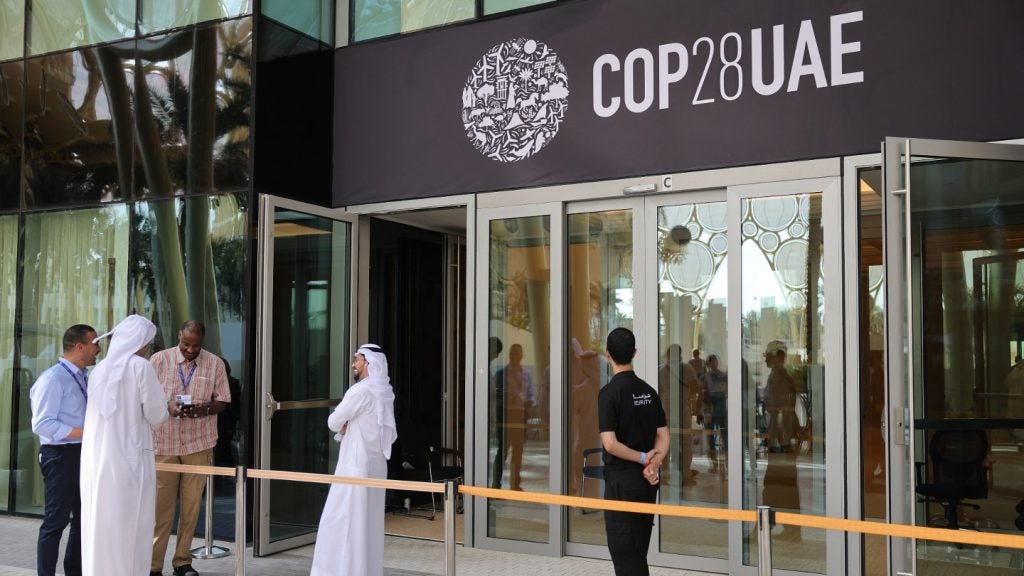
As COP28 kicks off in Dubai, pressure is mounting on the UN to force militaries to disclose their domestic and overseas greenhouse gas (GHG) emissions.
A 2022 estimate by international experts attributed approximately 5.5% of global GHG emissions to militaries, but there is no obligation to report or reduce their carbon footprint under the UN Framework Convention on Climate Change (UNFCCC).
At COP28, the UNFCCC will oversee a global stocktake of emissions, assessing progress on the Paris Agreement goals and setting future targets. However, this stocktake may be based on incomplete data.
Scientists and academics from universities including Oxford, Columbia, Harvard, Lancaster, Stanford, Durham and Queens Mary have released numerous studies outlining the hundreds of millions of tonnes of military carbon emissions that have gone unaccounted for in the stocktake.
Is reporting military emissions a security risk?
In 1997, military emissions were left out of the GHG-targeting Kyoto Protocol – and they were exempted again when the Paris Agreement was struck in 2015 on the grounds that energy use data could threaten armed forces’ security.
“Detailed emissions data could be leveraged by hostile actors to gain a better understanding of military readiness levels in specific regions,” says Tristan Sauer, defence analyst at GlobalData.
Environmental groups and academics have opposed this claim.
“If we think about the biggest security threats facing the world, is it militaries reporting their data – or the huge implications of the climate crisis?” Ellie Kinney, campaigner for the Conflict and Environment Observatory (CEOBS), tells Army Technology. “It’s incomparable.”
CEOBS works alongside the UN Environment Programme (UNEP) and has led calls for transparency around military emissions echoed by environmental groups including Tipping Point North South, Scientists for Global Responsibility, and the Transnational Institute.

Commercial arms contractors which are intertwined with global militaries do not identify the same risk in reporting emissions, according to Benjamin Neimark, a political ecologist and lecturer at Queens Mary University of London.
“Many of the weapons contractors which are part of what global militaries are already reporting their own emissions though CSR and ESG initiatives,” Neimark tells Army Technology.
Lockheed Martin, Northrop Grumman, Safran, Leonardo and Thales – which is part-owned by the French government – all report scope 1, 2 and 3 emissions despite supplying arms to highly sensitive military operations of the US Army and others.
Will military emissions make the COP28 agenda?
Russia’s invasion of Ukraine has brought a new focus on the environmental impact of conflict.
Hundreds of ecologically sensitive areas have been damaged, including industrial facilities, water and sanitation infrastructure, coal mines, and nuclear sites.
At COP27 last year, Ukraine said it had collected evidence of 2,000 environmental crimes with the intention of suing Russia for €37m ($40.4m). These include destruction of forests, release of toxic gases, and even the deaths of 120 dolphins in the Black Sea.
Researchers have estimated that the emissions for the first seven months of Russia’s invasion of Ukraine amounted to 100 million tonnes of CO2e – the same amount as the Netherlands’ total emissions over the same period.
CEOBS and other environmental groups say they are optimistic that military emissions reporting will be discussed in Dubai.
Kinney points to a “real increase in attention from media outlets” – but these indications go beyond lobby groups and media.
As part of the EU’s annual climate crisis resolution, MEPs called for a “proposal for the transparent accounting of military emissions to the UNFCCC” at COP28. There has also been a rise in reports on the topic from the European Defence Agency.
The EU holds significant influence at COP events. The bloc is its own signatory within the UNFCCC, on top of representing 27 member states.
Arguably, only the US will exercise more control over the COP28 agenda than the EU. Washington sent US Army and Navy representatives to COP27, marking the first time Pentagon delegates had attended the summit, and is expected to do the same in Dubai.
As the largest institutional consumer of energy in the US, the Department of Defense (DoD) has faced criticism for not instigating change on military emissions reporting.
“The DoD pushed to get the exemption [on militaries reporting emissions] in the first place,” Neta Crawford, Professor of International Relations at the University of Oxford, tells Army Technology. “They could push for better accounting – and publish better accounting right now.”
The emissions the DoD voluntarily reports, which Crawford says are incomplete, have decreased from 77 million metric tonnes CO2e in 2010 to 48 million metric tonnes CO2e in 2022.
Eco-friendly armies or military-grade greenwash?
The DoD has implemented various eco-friendly initiatives since releasing its 'Sustainability Plan' last year.
In October 2022, the DoD’s Defence Innovation Unit announced a partnership with renewable projects firms TechFlow to trial the use of EV charging points on US military bases.
According to GlobalData’s EVs in Defence report, the Unit also awarded a contract to GM Defense to develop a heavy-duty battery pack following a successful demonstration of the firm’s GMC Hummer EV platform earlier in July.
But the US military does not report fuel usage to Congress, or itemise how much fuel is expended in conflicts. Moreover, military air operations are among the most carbon intensive – and adoption of electric aircraft remains in its infancy.

“What the DoD should do is rethink missions and overall global footprint,” says Crawford. “Do we really need over 700 overseas bases and installations? Much of that military infrastructure is legacy.”
At the time of publishing, the US DoD had not responded to questions from Army Technology on emissions, sustainability emissions or COP28 ambitions.
Other experts point to the risks posed by climate change to military facilities themselves as reason enough to deescalate operations.
“Decarbonising militaries makes sense from a risk perspective,” says Neimark. “Just look at US Norfolk in Virginia, which is at risk of flooding due to sea level rise.”
The US has a larger military expenditure than any other country, amounting to $877bn in 2022, according to the Stockholm International Peace Research Institute.
With such vast resources and geopolitical influence, the US military has the opportunity to be a bellwether in reporting and reducing the GHG emissions of militaries worldwide.
Amid a mountain of academic research, environmental group pressure, and EU promises, all eyes now turn to Dubai.
Military emissions are the weak point in the world’s war on climate change – can COP28 bolster its environmental frontline?
Don’t miss our coverage of COP28! Subscribe here for exclusive insights & analysis.



